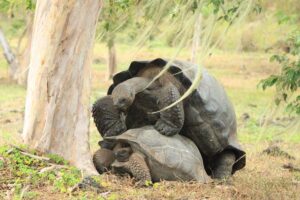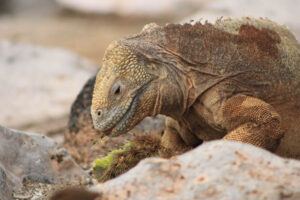ITINERARY B
8 DAYS - 7 NIGHTS

ITINERARY B - 8 DAYS
- Day 1 - Wednesday: Baltra / Santa Cruz: Highlands
- Day 2 - Thursday: Floreana Island: Post Office Bay, Cormorant Point and Devil’s Crown
- Day 3 - Friday: Española Island: Suarez Point & Gardner Bay
- Day 4 - Saturday: San Cristobal: Kicker Rock & Withces Hill & Interpretation Center
- Day 5 - Sunday: Santa Fe Island & South Plazas Island
- Day 6 - Monday: Genovesa Island: Prince Philip´s Steps & Darwin Bay
- Day 7 - Tuesday: Santiago Island: Sullivan Bay & Dragon Hill
- Day 8 - Wednesday: Santa Cruz Island: Black Turtle Cove & Baltra airport





ITINERARY B DAY BY DAY
 Arriving at Baltra airport, you are met by our certified naturalist guide, that accompanies you from the airport on a short bus and ferry ride to your private bus, to take you to the highlands of Santa Cruz to have lunch and to observe the famous giant tortoises that can weigh more than 400 pounds, and a variety of land birds like Darwin’s finches, flycatchers and yellow warblers.
Arriving at Baltra airport, you are met by our certified naturalist guide, that accompanies you from the airport on a short bus and ferry ride to your private bus, to take you to the highlands of Santa Cruz to have lunch and to observe the famous giant tortoises that can weigh more than 400 pounds, and a variety of land birds like Darwin’s finches, flycatchers and yellow warblers.
At the end of the afternoon is time to go to Grand Daphne, your home away from home, spend the evening relaxing, looking at the stars.
 Post Office: After breakfast a short tender ride and a wet landing on a white sandy beach takes you to visit the unique stampless mail service, that goes back hundreds of years, was originally used by the whalers stationed on the islands.
Post Office: After breakfast a short tender ride and a wet landing on a white sandy beach takes you to visit the unique stampless mail service, that goes back hundreds of years, was originally used by the whalers stationed on the islands.
Cormorant point: the landing is on a greenish sand beach that shines due to the olivine also know as peridot a semi-precious stone, the landscape is dominated by palo santo trees and mangroves, keep an eye out for flamingos, blue footed boobies and sting rays.
This island offers great snorkeling, with lots of tropical fishes with frequent sightings of sea turtles, rays, sharks, sea stars, and sea lions.
 Suarez Point: This is the oldest island in the archipelago, this day you will need good shoes to explore the resting and nesting locations of the Galapagos hawk, marine iguanas, the Nazca and blue footed boobies, also the home of the waved albatrosses from march to December, great places for landscapes pictures especially at the blowhole that spews water like a geyser.
Suarez Point: This is the oldest island in the archipelago, this day you will need good shoes to explore the resting and nesting locations of the Galapagos hawk, marine iguanas, the Nazca and blue footed boobies, also the home of the waved albatrosses from march to December, great places for landscapes pictures especially at the blowhole that spews water like a geyser.
Gardner bay: in the afternoon is time to embark on another expedition that takes you first to snorkel to see tropical fishes like parrots, surgeons, angelfishes and one of the best sites to look for sea lions, after there is a landing on one of the most beautiful beaches of the Galapagos, were is possible to go for a long walk on fine white sand, to admire the sea lions, mocking birds or just the perfect place to relax and enjoy the view.
 Start the day with a breath taking view of the kicker rock this volcanic ash cone was formed millions of years ago, it slowly erodes due to the wind and the ocean currents, is the home of frigate birds, sea gulls and other sea bird species, the adventure continues in the water, your guide and crew get the tender ready for you to go snorkeling, this is the ideal place to look for larger fish, like Galapagos sharks, rays and with a bit of luck hammerheads.
Start the day with a breath taking view of the kicker rock this volcanic ash cone was formed millions of years ago, it slowly erodes due to the wind and the ocean currents, is the home of frigate birds, sea gulls and other sea bird species, the adventure continues in the water, your guide and crew get the tender ready for you to go snorkeling, this is the ideal place to look for larger fish, like Galapagos sharks, rays and with a bit of luck hammerheads.
Then we will visit the Cerro Brujo area, which offers a perfect combination of stunning landscapes and abundant wildlife. Upon arrival, you will be greeted by a white sandy beach and crystal-clear waters that invite you to take a refreshing swim. Take a stroll along the shore and admire the majestic rock formations that rise from the sea, creating a magical environment. Additionally, you can enjoy panoramic views of the ocean.
After lunch and relaxing time a visit to the interpretation center to learn about the history and geology of the islands, this place is surrounded by a dry forest of palo santo trees, matazarno (iron wood) one of the hardest woods in the planet, also a place to see prickly pear cactus and Galapagos cotton, after there is time to walk in town to experience the way of living of the local community, at the end of the day San Cristobal says good bye with a sunset over the ocean.
 The turquoise water of the bay and splashing waves welcomes you to Santa Fe, after breakfast we disembark on a beach where there is a healthy population of sea lions that completely ignore our presence, the trail takes you across a dry forest in the search of the species of land iguana only found there, often you find the tame Galapagos dove, the morning experience ends with snorkeling from the tender.
The turquoise water of the bay and splashing waves welcomes you to Santa Fe, after breakfast we disembark on a beach where there is a healthy population of sea lions that completely ignore our presence, the trail takes you across a dry forest in the search of the species of land iguana only found there, often you find the tame Galapagos dove, the morning experience ends with snorkeling from the tender.
Later on the day we disembark on South Plaza, that welcomes everyone with a rookery of sea lions, this island is the home of various sea birds species that glide along side the cliffs with the help of the southern winds, one of the most spectacular features of the island is the red carpet of sesuvium that cover most of the island.
 Waking up inside a volcanic crater is an incredible experience, this is the home of thousands of birds, the landing takes the group on a search of the short eared owl that hunts during day time, you can also find red footed boobies, petrels, gulls and frigate birds.
Waking up inside a volcanic crater is an incredible experience, this is the home of thousands of birds, the landing takes the group on a search of the short eared owl that hunts during day time, you can also find red footed boobies, petrels, gulls and frigate birds.
On this location the water invites everyone to jump in, to snorkel with hundreds of colorful fishes, after enjoying the ocean your naturalist leads you on a relaxing walk were the variety of textures and colors makes you want to stay longer in this paradise.
 On the eastern coast of Santiago Island, you will find Bahia Sullivan. Embark on a walk along the pahoehoe lava trail, which was formed during an eruption in 1897 (approximately 1 hour). As you explore, keep an eye out for various fascinating wildlife such as marine iguanas, Sally Lightfoot crabs, sea lions, finches, turtles, sharks, and penguins. Throughout the walk, your knowledgeable naturalist guide will provide insights into the island’s geological history.
On the eastern coast of Santiago Island, you will find Bahia Sullivan. Embark on a walk along the pahoehoe lava trail, which was formed during an eruption in 1897 (approximately 1 hour). As you explore, keep an eye out for various fascinating wildlife such as marine iguanas, Sally Lightfoot crabs, sea lions, finches, turtles, sharks, and penguins. Throughout the walk, your knowledgeable naturalist guide will provide insights into the island’s geological history.
Next, we will travel to Cerro Dragón (Dragon Hill), one of the best locations to observe land iguanas in the Galapagos Islands. After a dry landing, embark on a walk towards a brackish lagoon, where you can spot various lagoon birds including stilts, pintail ducks, sandpipers, sanderlings, and flamingos. Further along the trail, you will be treated to a magnificent view of the bay and the western region of the archipelago. This area serves as a nesting site for land iguanas, which are closely monitored and protected by the Charles Darwin Research Station. The arid-zone vegetation in this area provides an ideal habitat for observing Darwin’s finches, Galapagos mockingbirds, the endemic Galapagos flycatcher, and yellow warblers. The path may pose some challenges, but the breathtaking view of the bay makes it all worthwhile.
 As the sun is rising the tenders depart to discover and area with lots of mangroves, were sea turtles find a place were to rest, it is also the home of juvenile fishes like sharks, mullets and rays.
As the sun is rising the tenders depart to discover and area with lots of mangroves, were sea turtles find a place were to rest, it is also the home of juvenile fishes like sharks, mullets and rays.
After the visit is time to go back to the yacht to get ready to head to the airport.
